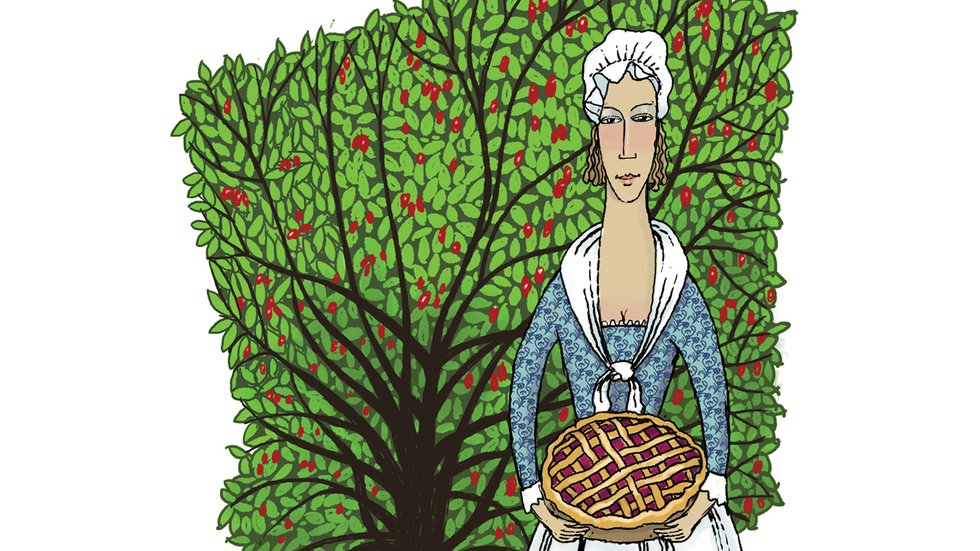The underappreciated mulberry is due for a delicious comeback.

Illustration by Robert Meganck
When the english settlers of the Virginia Company first arrived at what would be established as the Jamestown settlement in May of 1607, they began to record what they observed of this “new world” and its inhabitants. “Virginia doth afford many excellent vegitables and living Creatures,” noted John Smith, who included in his inventory “some great Mulberry trees,” which, he explained, could be “found growing naturally in prettie groves” as well as in close proximity to the dwellings of the native residents.
The mulberries, along with abundant strawberries, would have been ripening just as the settlers landed from their long sea journey and began their voyage up the James. “This was their first taste of the New World,” says Jeffrey Kirwan, an emeritus professor and extension specialist in the Department of Forest Resources and Environmental Conservation at Virginia Tech.
Virginia’s native mulberry is the red mulberry, or Morus rubra. It is the fruit of a fast-growing and fairly adaptable tree that likes moist, well-drained soils. Though the tree can reach heights of up to 60 or 70 feet, Kirwan explains it tends to have a low, spreading habit that makes it a “wonderful climbing tree.”
Kirwan, who is co-author with writer Nancy Hugo of the book Remarkable Trees of Virginia, is something of an unofficial historian of the mulberry tree in North America, which, he says, was in cultivation by American Indians long before the Jamestown colonists arrived. There are accounts of mulberry groves, he says, going back as far as the records of Spaniard Hernando de Soto, who explored the southeastern regions of the future United States in the mid-1500s, and of the French Huguenot colonists in Florida a few decades later.
“They seem to grow just about everywhere they’ve been planted and tended,” says Kirwan. “This may be a semi-domesticated species in the sense that the trees come up even where you don’t want them to come up. Its presence on the landscape may be related to where people used to live and planted it, and what we see now are second and third and fourth generation trees.”
Thanks to the birds that enjoy its fruit, mulberry also naturalizes readily, adds Katie Trozzo, a Ph.D. candidate in agroforestry at Virginia Tech. “They are so abundant in the Piedmont area and in Northern Virginia,” says Trozzo. “It’s a really great foraging plant.”
Interestingly, the history of the mulberry in the U.S. includes a second, introduced species: Morus alba, or white mulberry, which is native to Asia (where, among other uses, its leaves are fed to silkworms). Most accounts say it was imported during Colonial times in hopes of starting a silk industry here; according to a U.S. Forest Service fact sheet on the plant, “In 1624 the legislature of Virginia required every male resident to plant at least four white mulberry trees to promote a North American silk industry.” In the 1800s, there was even a brief period of “mulberry mania” for the trees.
At any rate, although the silk industry failed to take hold, the white mulberry itself was another matter. It has proliferated throughout North America to the point where in some areas it is considered invasive. Confusingly, although Morus alba is known as “white” mulberry, its fruit can range in color from creamy pale to purple, and it’s not always easy to tell the “alba” from the “rubra.” However, the fruit of Morus rubra, when fully ripe, is always a deep purple-red: “a blackberry-looking thing on a tree,” is how Trozzo describes it.
Botanically speaking, a mulberry is not actually a true “berry” (neither, for that matter, are blackberries or raspberries, although—go figure—bananas are). It is in fact an aggregate, or collective fruit, each individual not-berry a collection of very small individual fruits known as “drupes.” These drupes are soft and squash easily, so another way to know you’re standing beneath a mulberry tree “is if you see big purple stains,” says Trozzo.
Perhaps because mulberries have this reputation for leaving sidewalks and patios looking like Harold and his purple crayon guest-starred in a crime-scene procedural, “Mulberry is not something that is on many people’s list to plant,” admits Kirwan. But both Kirwan and Trozzo think this underappreciated native is overdue for greater recognition. Kirwan has planted several around his home and, he says, he reaps a harvest every summer that he freezes and enjoys with his breakfast all winter.
“It is an all-around champion,” says Trozzo. “It is easy to grow, it fruits abundantly, and the fruit is delicious. It is a huge gift.”








